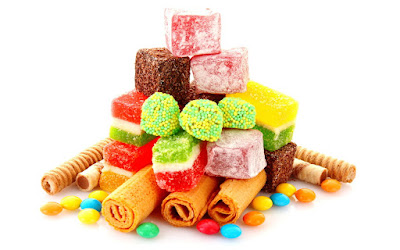A Confectionery Is The Art Of Making Sugary, Carbohydrate-Rich Food Items
 |
| Confectionery |
Typically, Confectionery
items have high calorie counts and minimal nutritional values. New product
categories, such sugar-free confectionery items, have emerged as a result of
increased health awareness and the rising incidence of lifestyle disorders like
diabetes, hypertension, and heart disease. Market expansion is anticipated to
be aided by rising consumer demand for products that are sugar-free, low in
calories, and organic. Confectionery uses sugar
alternatives as sorbitol, mannitol, maltitol, and lactitol among others. The
Hershey Company and Chocoladefabriken Lindt & Sprüngli A.G. are two
companies that sell sugar-free chocolates, mints, toffees, candies, and
jellies.
However, confectionery
is typically classified into three groups:
1. The majority of flour confections are sweet pastries,
cakes, and similar baked items.
2. Sweets, candied nuts, chocolates, chewing gum, sweetmeats,
pastillage, and other confections produced predominantly of sugar are referred
to as sugar Confectionery.
3. Sugar-free variations of sugar confections are treated as
a separate category, as are chocolate confections (confections made of
chocolate).
Formulas and
Measurements of Confectionery-
Bakers typically discuss formulas as opposed to recipes. The
bake shop is quite similar to a chemistry lab in terms of both the complicated
reactions that happen during mixing and baking and the scientific correctness
of the methods. In a bakery, ingredients are usually always weighed rather than
measured by volume since weight measurements are more precise. In a bakery,
measurement precision is crucial. Scaling is the phrase used by bakers to describe
weighing ingredients. In some cases, ingredients like water, eggs, and milk can
be measured by volume at a ratio of 1 lit./Kg.
As the name implies, sugar confectionery is loaded with
sugar—any kind of sugar. Sugar Confectionery come in two flavors: fondant and
boiled sweets. In contrast to fondant, which is described as "Minute sugar
crystals in a saturated sugar syrup; used as the creamy filling in chocolates
and biscuits and for decorating cakes," boiled sweets are described as
"Sugar and water boiled at such a high temperature (150-166 °C) that
practically no water remains and a vitreous mass is formed on cooling."
This is made by fast cooling while stirring a sugar solution while it is
boiling while adding glucose syrup or an inverting agent.
About 39% of candy consumption is made up of sugar confections,
and about 61% of it is made up of chocolate confections. Between nations, this
ratio can differ significantly. Both nations with a developing middle class,
like Brazil and India, and those with historically low sugar consumption, like
China and Japan, are seeing an increase in confectionery consumption. The
consumption of chocolate tends to rise as economies develop. In more
industrialised nations, consumption of sweets grows very slowly year after year
and even decreases in some places.
Emulsifiers are useful in both chocolate and sugar
confectionery products, as research has shown. Lecithin is most frequently used
in chocolate to reduce viscosity and make handling easier in Confectionery products.
Polyglycerol polyricinoleate, another emulsifier used in chocolate, is used to
alter the viscosity of chocolate coatings.



Comments
Post a Comment